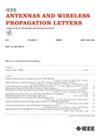A Miniaturized and High Q-Factor Wireless Passive Frequency Selective Surface Temperature Sensor Based on Stacking Coupling Structure
IF 3.7
2区 计算机科学
Q2 ENGINEERING, ELECTRICAL & ELECTRONIC
引用次数: 0
Abstract
Metamaterial temperature sensors are gaining increasing attention due to their wireless passive operation. Most metamaterial temperature sensors are single-layer resonance structures, which are limited in terms of miniaturization and high quality factor (Q-factor). In order to alleviate these issues, a frequency selective surface (FSS) temperature sensor based on stacking coupled inductive and capacitive layers is proposed in this work. By stacking metal layers in three dimensions, the equivalent inductance or capacitance can be adjusted independently at each layer. In addition, the equivalent capacitance has significantly increased with the proposed new wide strip and interdigital patch structures. The size of the FSS unit cell is as compact as 0.09λ 0 . The measured results show that the Q-factor of the FSS sensor is about 1383 GHz at 16.797 GHz, and the resonance frequency of the FSS sensor decreases from 16.732 GHz to 15.609 GHz when temperatures increase from 25 °C to 900 °C. The average sensitivity of the sensor is 1.29 MHz/°C. Being wireless, passive and miniaturized, the proposed high-temperature sensor can be used for various industrial systems.基于堆叠耦合结构的微型高 Q 因子无线无源频率选择性表面温度传感器
超材料温度传感器由于其无线无源工作特性而受到越来越多的关注。大多数超材料温度传感器都是单层谐振结构,在小型化和高质量因子(q因子)方面受到限制。为了解决这些问题,本文提出了一种基于电感和电容层叠加耦合的频率选择表面(FSS)温度传感器。通过在三维空间中堆叠金属层,可以在每一层上独立地调整等效电感或电容。此外,所提出的新型宽带和数字间贴片结构显著提高了等效电容。FSS晶胞的尺寸为0.09λ0。测量结果表明,当温度从25℃升高到900℃时,FSS传感器在16.797 GHz时的q因子约为1383 GHz,谐振频率从16.732 GHz降低到15.609 GHz。传感器的平均灵敏度为1.29 MHz/℃。该高温传感器具有无线、无源和小型化的特点,可用于各种工业系统。
本文章由计算机程序翻译,如有差异,请以英文原文为准。
求助全文
约1分钟内获得全文
求助全文
来源期刊
CiteScore
8.00
自引率
9.50%
发文量
529
审稿时长
1.0 months
期刊介绍:
IEEE Antennas and Wireless Propagation Letters (AWP Letters) is devoted to the rapid electronic publication of short manuscripts in the technical areas of Antennas and Wireless Propagation. These are areas of competence for the IEEE Antennas and Propagation Society (AP-S). AWPL aims to be one of the "fastest" journals among IEEE publications. This means that for papers that are eventually accepted, it is intended that an author may expect his or her paper to appear in IEEE Xplore, on average, around two months after submission.

 求助内容:
求助内容: 应助结果提醒方式:
应助结果提醒方式:


